Summary
When a piece of flat aluminium foil is pricked by a needle in allyl chloride-toluene solution, a red colored spot appears there instantly. On the red spot, a light yellow sheath-like product grows continuously at the rate of about 3 cm/hr. Since the product is composed of polymers and has the definite growth point like the bud of the plant, the growth might be regarded as more well fitting model of biological growth than the models ever known (e. g. Traubes artificial cell and chemical or flower gardens). When a line is drawn by a knife on the foil in the solution, the color of the line instantly changes to red, and a thin plate-like product grows on the red line. Thus any letter can be written at will with a knife on aluminium foil as with a red pencil on white paper. And then, on the red letter, a light-yellow structure grows.
Zusammenfassung
Wenn ein Stück einer flachen Aluminiumfolie mit einer Nadel in einer Allylchlorid/Toluol-Lösung angestochen wird, erscheint an diesem Punkt rasch ein rotgefÄrbter Fleck. Auf dem roten Fleck wÄchst kontinuierlich mit einer Geschwindigkeit von ungefÄhr 3 cm pro Std. ein leicht gelbes sackÄhnliches Produkt. Da dieses Produkt aus Polymeren besteht und einen definierten Wachstumspunkt wie den Keim einer Pflanze besitzt, könnte das Wachstum als noch besser passendes Modell eines biologischen Wachstums als die bisher bekannten Modelle angesehen werden (z. B. Traubes künstliche Zellen und chemische BlumengÄrten). Wenn man eine Linie mit einem Messer auf der Folie in der Lösung einritzt, so wird diese Linie rasch rot gefÄrbt, und ein dünnes plattenÄhnliches Produkt wÄchst auf der roten Linie. So kann jeder beliebige Buchstabe mit einem Messer auf der Aluminiumfolie so geschrieben werden wie mit einem roten Stift auf wei\em Papier. Anschlie\end wÄchst auf dem roten Buchstaben eine leicht gelbe Struktur.
Similar content being viewed by others
References
Okuyama, M. and H. Hirata, Nippon Kagaku Zassi, J. Chem. Soc. Jap. 85, 342 (1964) (in Japanese).
Leduc, S., Théorie Physico-Chimique de la Vie et Générations Spontanées (Paris 1910);
Sanae Hagi. Kagaku Chemistry 7, 594 (1952); 8, 588 (1953) (in Japanese).
The reaction mechanism was discussed by H. Hirata and M. Okuyama at the 12th Symposium of High Polymer, Nagoya, Japan November, 1963.
Author information
Authors and Affiliations
Rights and permissions
About this article
Cite this article
Okuyama, M., Hirata, H. A model of biological growth. Kolloid-Z.u.Z.Polymere 212, 162–165 (1966). https://doi.org/10.1007/BF01553083
Received:
Issue Date:
DOI: https://doi.org/10.1007/BF01553083




